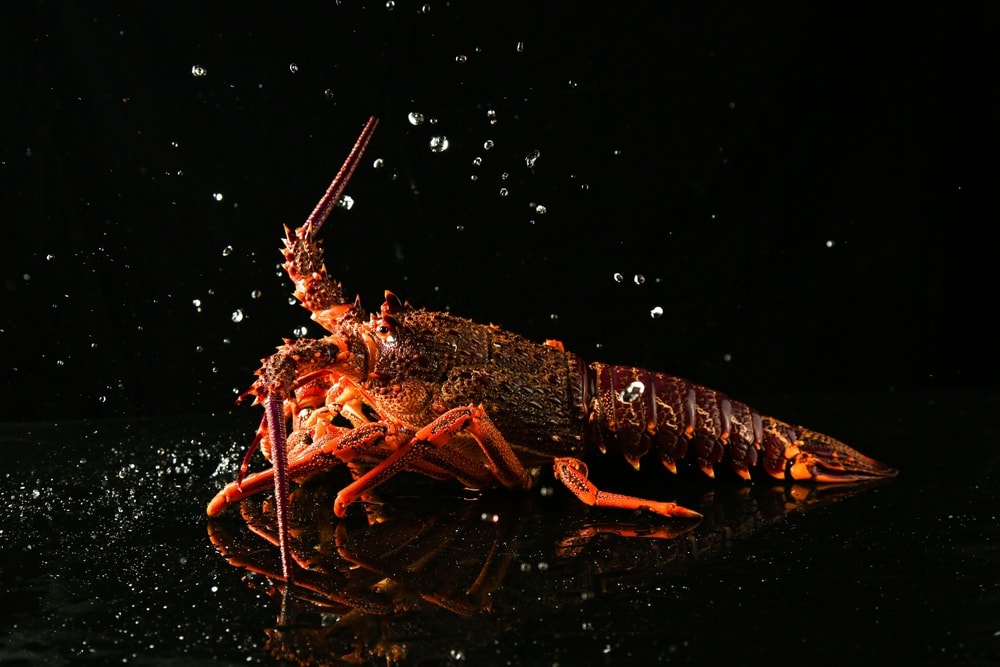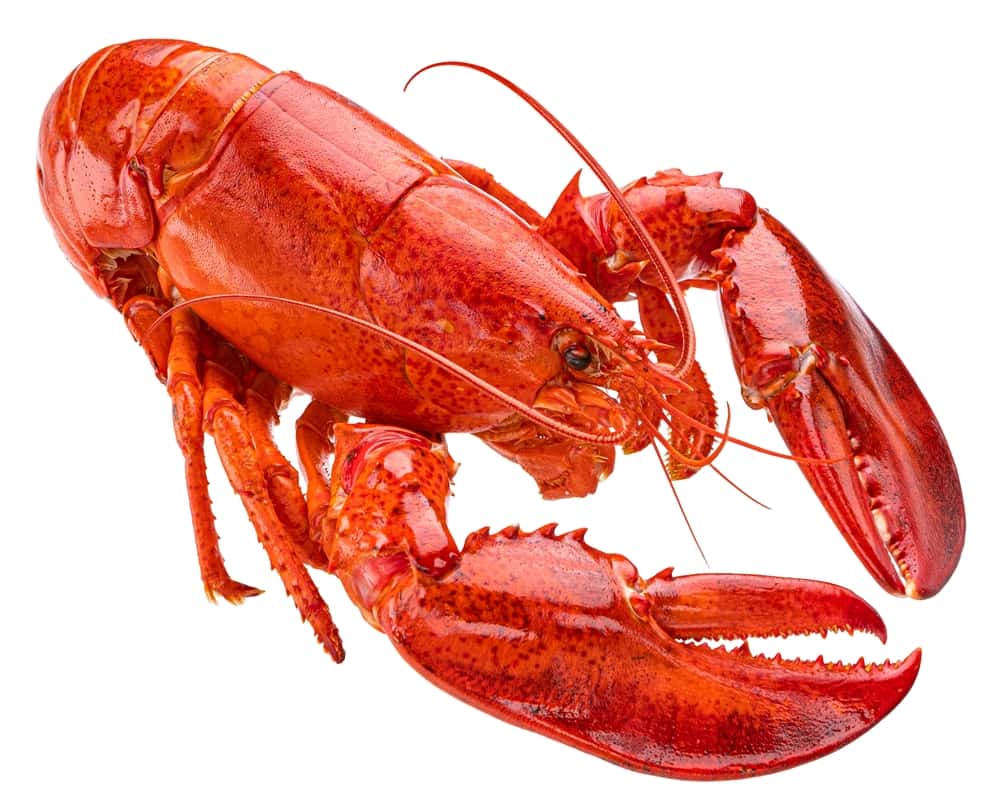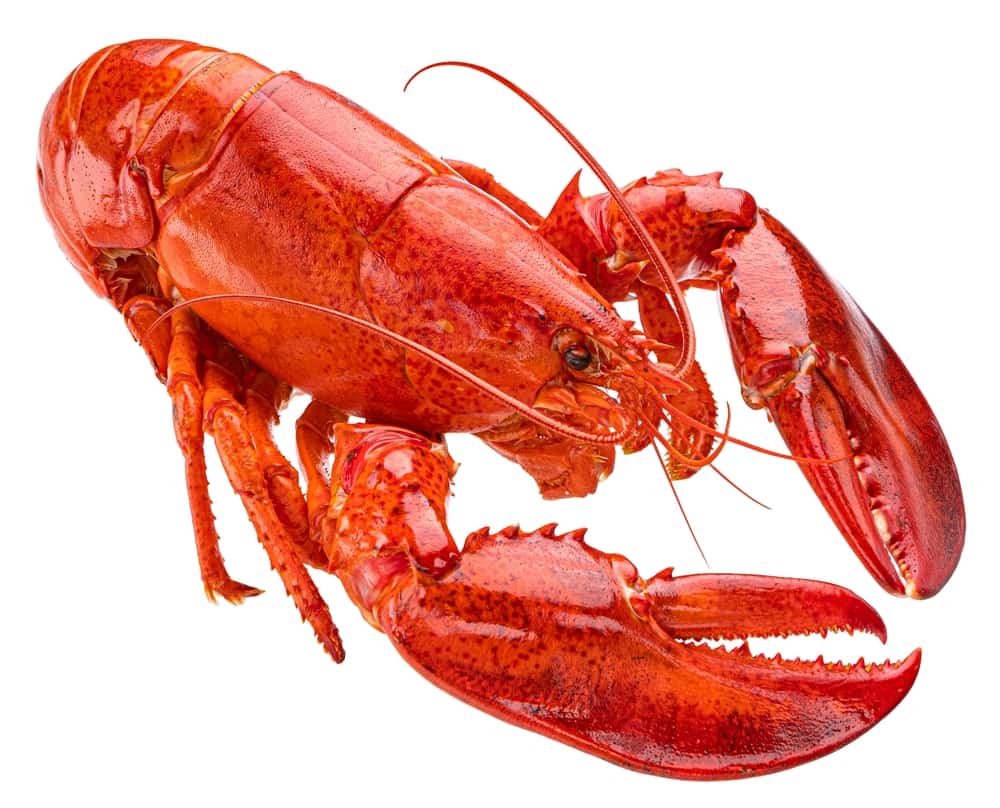
A lobster displays its mighty claws, which are nature’s built-in tools of strength.
©xiaoxiao9119/Shutterstock.com
Ever found yourself gazing at a lobster in an aquarium, captivated by its majestic claws and pondering just how powerful they might be? Trust us, you’re in good company. Lobsters, with their vibrant shells and intriguing behaviors, have a way of drawing us in. But it’s those impressive claws that often steal the show.
Now, let’s dive a bit deeper (pun intended!). Lobsters aren’t just flaunting those claws for fun. They’re essential tools in their daily lives, playing a pivotal role in everything from hunting to self-defense. Imagine having a Swiss Army knife attached to you. Pretty handy, right?
But how do these claws measure up, especially when compared to our human strength or even other animals? Let’s embark on a journey to uncover the secrets behind the strength of lobster claws. Along the way, we’ll explore some fun facts, debunk myths, and maybe even share a chuckle or two. Ready to dive in? Let’s get cracking.
The Anatomy of a Lobster Claw
Ever noticed that not all lobster claws are created equal? These crustaceans come equipped with two distinct claws, each with its unique job description. It’s a bit like the dynamic duo of your kitchen drawer: the trusty scissors and the ever-reliable hammer.
Let’s break it down:
The Sleek Slicer
This is the lobster’s sharp and slender claw. Think of it as a precision tool, perfect for slicing and dicing. Whether it’s snipping off a piece of food or navigating through tricky terrains, this claw is all about finesse and agility.
The Mighty Masher
On the flip side, we have the broader, beefier claw. This one’s the powerhouse, built for some serious crushing action. From smashing prey to warding off potential threats, it’s the lobster’s go-to for heavy lifting.
But here’s the real kicker: these claws aren’t just functional; they’re a testament to the lobster’s adaptability and evolution. Over time, lobsters have fine-tuned their anatomy to thrive in their environments, and these claws are a shining example of that. So, next time you spot a lobster, take a moment to appreciate those claws. They’re not just appendages; they’re marvels of nature, each with its own story to tell.

The rugged design of a lobster’s crushing claw is built for power.
©Spalnic/Shutterstock.com
Why Lobsters Have Strong Claws: More Than Just a Show of Strength
Ever wondered why lobsters strut around with those beefy claws of theirs? It’s not just to impress their crustacean friends or to give us humans a good show at the aquarium. No, there’s a deeper, more survival-centric reason behind those powerful pincers.
The Wild Ocean Playground
The underwater world is teeming with action. From cunning predators lurking in the shadows to territorial disputes among fellow sea creatures, it’s a bustling place. Lobsters, being part of this dynamic ecosystem, need to be on their A game. And those strong claws? They’re the lobster’s MVPs in this underwater league.
The Hunter’s Toolkit
While lobsters might seem like the laid-back dudes of the ocean floor, they’re quite the hunters. Those claws act as their primary hunting tools, helping them catch, hold, and devour their prey. It’s like having a built-in fork and knife, always ready for mealtime.
Defense Mechanism Extraordinaire
The ocean can be a dangerous place, and lobsters are well aware of it. Those claws aren’t just for offense; they’re the lobster’s first line of defense. Whether it’s fending off a curious fish or giving a warning snap to a potential threat, those claws are always on guard duty.
Establishing the Pecking Order
In the lobster world, dominance matters. And what better way to establish superiority than with a show of strength? Those mighty claws play a pivotal role in lobster-lobster interactions, helping determine who’s the boss in any given territory.
In essence, a lobster’s claws are its Swiss Army knife – versatile, functional, and downright essential for its survival. The next time you’re marveling at a lobster’s impressive claws, remember: they’re not just for show. They’re a testament to the lobster’s resilience, adaptability, and sheer will to thrive in the vast, unpredictable ocean.
The Crushing Claw vs. The Fast Claw: Nature’s Perfect Balance of Power and Precision
Lobsters, with their armored exteriors and intriguing behaviors, are among the ocean’s most captivating residents. But it’s their claws that truly showcase their evolutionary genius. These dual appendages, each with its distinct purpose, highlight the lobster’s adaptability and the intricate balance of nature.
The Crushing Claw: The Powerhouse of the Deep
Have you ever wished for a tool that could effortlessly break through barriers? Something that embodies sheer power and resilience? Well, lobsters don’t have to imagine. They come equipped with their very own built-in sledgehammer: the crushing claw.
Design and Function
This claw is the epitome of strength. With its robust build and dense muscle structure, it’s crafted to exert formidable force. The inner surface is typically rough, almost molarlike, perfect for grinding and crushing.
Role in the Wild
In the vast expanse of the ocean, the crushing claw is the lobster’s trusty tool for breaking open hard-shelled prey like crabs or mollusks. But it’s not just about food; this claw also plays a pivotal role in defense. When faced with potential threats, a swift clamp from this powerhouse can deter many predators.
Symbolism
If we were to draw a parallel, the crushing claw is like a heavyweight boxing champion. It’s all about raw power, delivering knockout blows, and standing its ground.
The Fast Claw: The Maestro of Precision
While the crushing claw of the lobster might steal the limelight with its raw power, there’s another star that deserves equal attention. Enter the fast claw, a marvel of nature that epitomizes agility, precision, and finesse.
Design and Function
Sleek, streamlined, and armed with sharp edges, the fast claw is built for speed. It’s the lobster’s precision instrument, designed for tasks that require a more delicate approach.
Role in the Wild
This claw is essential for catching swift-moving prey, like small fish or shrimp. Its sharp pincers can grasp and hold onto slippery targets with remarkable efficiency. Additionally, the fast claw aids in intricate tasks like grooming or navigating through narrow crevices.
Symbolism
Drawing a parallel from the human world, the fast claw is reminiscent of an elite fencer. It’s about swift movements, accuracy, and tactical strikes. Every move is calculated, every strike precise.
In essence, the dual claws of a lobster represent a harmonious blend of power and precision, showcasing nature’s incredible ability to equip its creatures with the tools they need to thrive. It’s a testament to the lobster’s evolutionary journey and a reminder of the wonders that lie beneath the ocean’s surface.

Marvel at nature’s design, which reveals the intricate muscle structure inside a lobster’s claw.
©Yellowj/Shutterstock.com
Decoding Strength: A Deep Dive into Lobster Claw Measurements
The tales of a lobster’s formidable pinch have been passed down through generations, often evoking images of old sailors and fishermen sharing stories of their encounters with these marine marvels. But beyond the tales and legends, there’s a world of scientific precision that seeks to understand the true strength of a lobster’s claw.
The Intersection of Curiosity and Science
The strength of a lobster’s claw isn’t just folklore; it’s a subject of genuine scientific intrigue. Biologists and marine scientists have long been curious about the force behind that iconic pinch. But how do they transition from mere curiosity to quantifiable data?
The Tools of the Trade: State-of-the-Art Equipment
In the quest to measure the strength of a lobster’s claw, standard tools just won’t cut it. Enter the world of specialized equipment, meticulously designed for marine research.
Force Transducers
These are sensitive devices that can measure the force exerted by the lobster’s claw. When the claw clamps down on the transducer, it captures and records the force of the pinch.
Pressure Chambers
Some researchers use pressure chambers to simulate different depths and environmental conditions, ensuring that the lobster’s natural behavior is taken into account during measurements.
High-Speed Cameras
To complement the force measurements, high-speed cameras can capture the rapid motion of the claw’s snap, providing valuable insights into the biomechanics of the action.
The Measurement Process: A Delicate Dance
The measurement process begins by gently coaxing the lobster to use its claw. By applying consistent and controlled pressure using the equipment, the lobster is prompted to react, leading it to clamp down. This reaction isn’t just a random snap; it’s the lobster’s natural response to potential threats or prey.
Next, at the precise moment of the snap, the equipment captures the force exerted. This data, often recorded in real-time, is then analyzed to quantify the strength. The results are typically presented in tangible metrics, such as pounds or kilograms of force, making it easier to comprehend and compare.
The quest to understand the strength of a lobster’s claw is a beautiful blend of age-old curiosity and cutting-edge science. It’s a journey that takes us from the tales of old sailors to the sophisticated labs of today’s marine biologists. And at the heart of it all is the lobster, a creature that continues to fascinate, inspire, and surprise us with its blend of power and precision.
Lobster Claw Strength: Crunching the Numbers and Unveiling the Power
When it comes to strength, lobsters are the unsung heroes of the marine world. But how do they truly measure up, especially when compared to us humans? Let’s dive into the numbers and unravel the mysteries of lobster strength.
Human Hand Strength: The Marvel of Evolution
Our hands are among the most versatile tools in the animal kingdom. From crafting intricate art to lifting heavy weights, they’re capable of a vast range of tasks.
The Numbers
The average human hand, with its complex network of muscles, tendons, and bones, can exert a grip force ranging from 20 to 30 kilograms. This might seem modest, but when you consider the variety of tasks our hands perform daily, it’s genuinely remarkable.
Evolutionary Perspective
Our ancestors needed strong grips for survival tasks like hunting, gathering, and crafting tools. Over time, as we evolved, so did our hand strength, adapting to our changing needs and environments.
Versatility Over Raw Power
While our grip strength is impressive, it’s the adaptability and dexterity of our hands that truly stand out. We might not have the strongest grip in the animal kingdom, but our hands are unparalleled in their versatility.
Lobster’s Crushing Claw: The Powerhouse of the Ocean
Lobsters, especially the seasoned veterans of the ocean floor, are powerhouses when it comes to grip strength.
The Numbers
Hold onto your diving masks, because the numbers are staggering! A mature lobster’s crushing claw can exert a force that surpasses 100 pounds per square inch!
Visualizing the Strength
To truly grasp this, picture trying to hold onto three lively, full-grown cats, each determined to wiggle out of your grip. It’s a challenging feat, to say the least, and that’s the kind of power we’re talking about with lobsters.
Evolutionary Mastery
This incredible strength didn’t develop overnight. Over the years, lobsters have evolved to have such powerful claws, ensuring their survival against predators and helping them secure their meals. Their environment demanded strength, and nature delivered in the form of the mighty crushing claw.
The bottom line?
While we humans pride ourselves on our hand’s adaptability and versatility, lobsters reign supreme in the raw power department. It’s a beautiful reminder of nature’s diversity and the different paths creatures have taken to thrive in their unique environments.

Meet the heavyweight champion of the ocean: the lobster’s crushing claw.
©Spalnic/Shutterstock.com
Lobster Defense 101: The Power of the Pinch
Lobsters aren’t just passive prey waiting to be snatched up. They’re equipped with the following set of tools and tactics to fend off potential threats.
The Warning Snap
Before going all out, a lobster might deliver a quick snap with its claws, a clear warning to potential predators that it’s not to be trifled with.
Full Force Pinch
If the warning goes unheeded, the lobster can exert its full strength, delivering a powerful pinch that can deter, injure, or even maim an attacker.
Severing Strategy
In extreme situations, a lobster can use its crushing claw to sever an attacker’s limb. It’s a last resort tactic, signaling the lengths a lobster will go to ensure its survival.
Retreat and Camouflage
Sometimes, the best defense is a good escape. Lobsters can swiftly retreat backward into crevices or under rocks. Their mottled, rocky appearance also aids in camouflage, allowing them to blend seamlessly with the ocean floor.
In short, the life of a lobster in the wild is a testament to nature’s balance of power and vulnerability. While they face numerous threats, their evolutionary toolkit, especially those mighty claws, ensures they’re no easy target. It’s a dance of survival, where strength, strategy, and a bit of luck play pivotal roles.
Fun Facts About Lobster Claws: Marvels, Myths, and Mighty Battles
Lobsters, with their iconic claws and armored bodies, are a source of endless fascination. But beyond their culinary appeal and their role in the marine ecosystem, there’s a world of intriguing facts and behaviors that make these crustaceans even more captivating.
Let’s dive into some fun tidbits about lobster claws!
The Wonders of Lobster Regeneration: A Deep Dive into Nature’s Marvels
The animal kingdom is filled with incredible feats and adaptations, but few are as awe-inspiring as the ability to regenerate lost body parts. Lobsters, those armored denizens of the deep, stand out as prime examples of nature’s regenerative powers. Let’s explore the magic behind this phenomenon.
The Magic of Molting: Nature’s Reset Button
Lobsters possess a remarkable trait that allows them to bounce back from injuries: molting. As these crustaceans grow and age, they periodically shed their old exoskeleton, making way for a new, larger one. This process isn’t just about growth; it’s a window of opportunity. If a lobster has lost a limb, the molting phase kickstarts the regeneration process, setting the stage for a brand new limb to emerge.
A Gradual Process: Patience and Perseverance
While the concept of limb regeneration might sound like a plot from a sci-fi novel, for lobsters, it’s a slow and steady journey. The initial regrowth might be small, perhaps even rudimentary. However, with each subsequent molt, the new limb becomes more defined, eventually restoring its full functionality. It’s a testament to nature’s design, ensuring that even after setbacks, life finds a way to thrive.
Not Just Claws: The Spectrum of Regeneration
While their powerful claws often steal the spotlight, lobsters have more tricks up their sleeves—or should we say, under their shells? Beyond claws, lobsters can regenerate antennae, vital for sensing their environment. Lost a leg? No worries, it’ll grow back. Even parts of their protective carapace can regenerate, showcasing the lobster’s incredible resilience and adaptability.
The world of lobsters offers a captivating glimpse into nature’s boundless ingenuity. Their ability to regenerate, to rise from setbacks, and to continually adapt is a reminder of the wonders that lie beneath the ocean’s surface. It’s a story of resilience, of nature’s intricate designs, and life’s enduring spirit.

Glimpse into the lobster’s world, where every claw tells its unique tale of strength and survival.
©Haland/Shutterstock.com
The Marvel of Lobsters
Lobsters, with their iconic claws, are more than just oceanic wonders; they’re symbols of nature’s resilience and adaptability. These claws, honed over time, serve as tools for survival, defense, and dominance in their marine environment. So, the next time you encounter a lobster, appreciate the evolutionary journey behind those powerful pincers. They’re a testament to the lobster’s enduring strength and the intricate dance of life beneath the waves!
The photo featured at the top of this post is © /Shutterstock.com
Thank you for reading! Have some feedback for us? Contact the AZ Animals editorial team.







